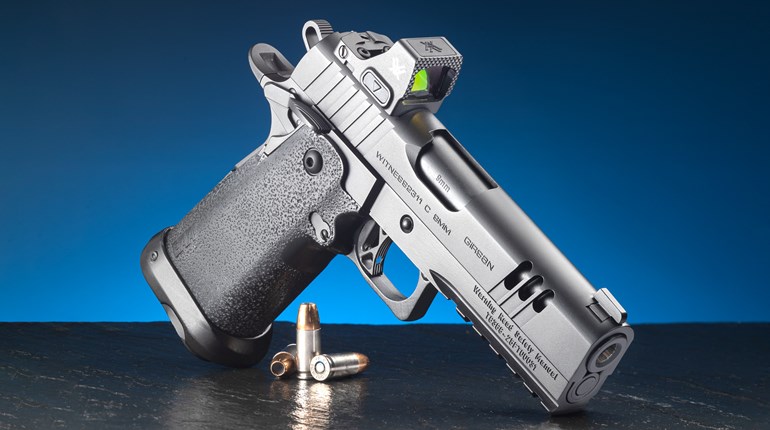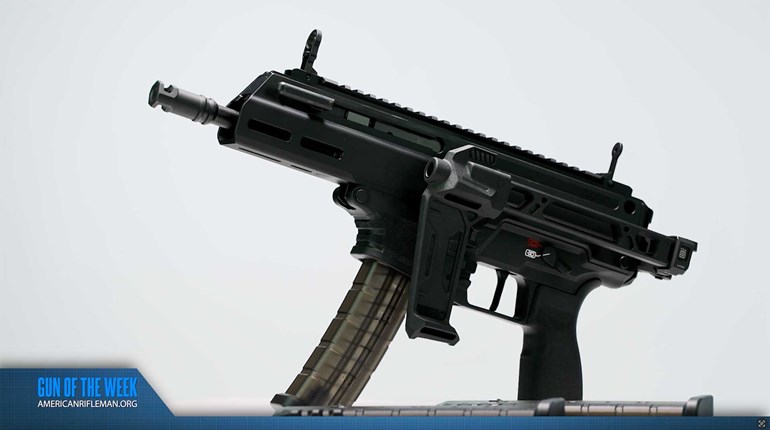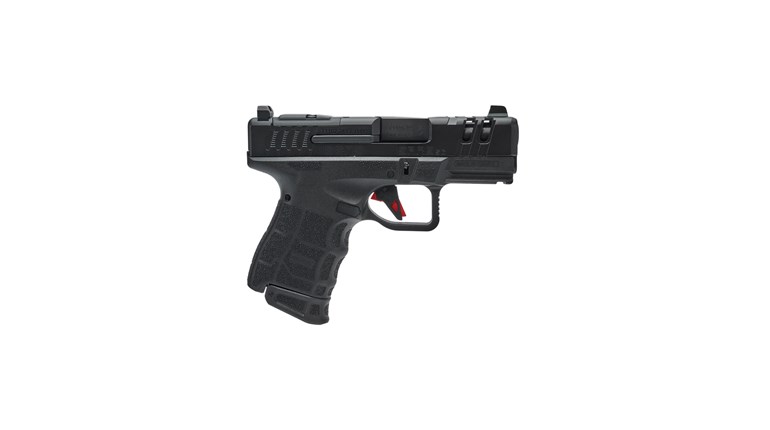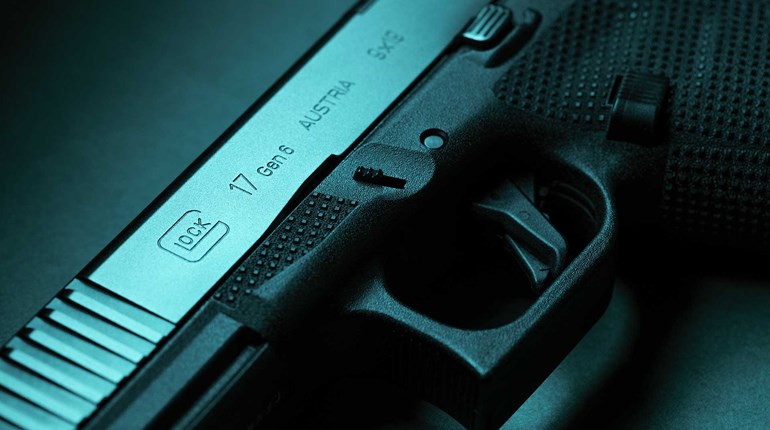
I actually wear several hats as a gunwriter. When I’m writing editorially—such as in my “Handguns” column here at Shooting Illustrated or on my own personal blog—I’m free to opine on things that are purely subjective, offering readers my opinion on topics like “Why cats make better pets for introverts than dogs” or “Why .312-inch-diameter projectiles launched with sufficient energy are ideal rounds for normie-private-citizen-CCW use and all y’all folks who call them ‘mouseguns’ are just wrong.”
But, when I’m reviewing a firearm for the magazine, it’s my duty to set all that aside and be completely objective. When it comes to firearm reviews, I need to stick to classic journalism ethics, so sorely forgotten these days, and deliver just the “Five Ws:” the Who, What, When, Where and Why of the firearm in question. Just the facts. Part of that is treating the gun being tested as a unique firearm, in and of itself, without dragging in personal biases.
It seems that Springfield Armory would like everyone to do this with the pistol at hand. It’s an absolutely clean-sheet-of-paper design, and Springfield and its partners at HS Produkt in Croatia are emphasizing this fact, starting with the name of the pistol itself. It’s not being branded as the “XD-C” or the “XD-X” or the “XD-Anything;” it’s the Echelon. It’s an ambitious new design that’s looking to conquer new markets and, if it must break with past brand identification a little bit to do so, well, so be it.
The XD line (lines, actually) has been a commercial success for Springfield Armory. They’ve seen consumer acceptance in the U.S. and a fair amount of success in the field of competitive shooting, but in one corner of the industry they remained kind of the Rodney Dangerfield of striker-fired polymer pistols: They couldn’t get “no respect” from the most tacticool corners of the gunternet, mostly because of their lack of adoption by large domestic law enforcement agencies (for a host of complicated reasons, some of which we’ll touch on later).
The new Echelon seems determined to burst out of that confining image and grab the duty-gun bull by the horns. As if to transmit that intent as clearly as possible, the sample pistol arrived with a Trijicon RMR already mounted and a SureFire X300U in the box, as well as a Safariland gun bucket of the type you’d see on the hip of some SWAT or SOCOM dude, rotating SLS optics-protecting hood and all. That’s not a setup for casual paper-punching at the neighborhood indoor range.
If all one looks at is its most basic specifications, there’s not a lot about the Echelon that’s going to grab anyone’s attention.

At first glance it’s a polymer-frame, striker-fired 9 mm duty-type handgun with a 17-round magazine and a 4.5-inch-barrel. You literally can’t swing a cat in a gun shop these days without knocking a dozen or more pistols that fit that description off its shelves (to say nothing of the mess you’d make and how much trouble you’d be in when the cops and the ASPCA got there—if the cat didn’t claw the bejeezus out of you first).
“But, Tam,” you exclaim, “Doesn’t Springfield Armory already have this kind of pistol, in the shape of the XD-whatever suffix it is currently selling?”
Ah, but as the name indicates, this is not that.
For starters, unlike the XD series, the Echelon is a chassis-type pistol, and Springfield Armory has taken the level of modularity this allows to the next level.
The chassis mechanism itself is made of tool steel and all the sproing-y bits are encircled within the frame. The polymer grip module that holds this chassis not only comes in three diameters (small, medium and large) that govern trigger reach, but also each grip module has interchangeable backstraps and the backstraps also come in three different dimensions.
I’m a writer, OK? I took the minimum amount of arithmetic to get out of high school, ending with a D in Trig and bailing on the math track before I could humiliate myself in Algebra II, but even I know that “Glock times four backstraps” and “SIG times three grip modules” both yield smaller numbers than “Echelon times three grip modules times three backstraps.”
Stop laughing, I’ll get my points back in the spelling bee.
Oh, and as an added bonus, the backstraps themselves have a metal pin protruding from the top that serves as an armorer’s tool. Pretty nifty.

The grip part of the frame has a relatively pleasing ovoid cross section, at least on the medium module that shipped with the test gun, avoiding the blocky frontstrap contours that were endemic to the pioneers of the double-stack, polymer-service-pistol genre. The majority of the grip’s diameter is covered in a roughened texture that’s more aggressive than early SIG Sauer P320s, if not nearly as grabby as an RTF Glock or FN Edge texture.
Unless your palms are covered in an unusually nasty slime of sweat, CLP and sunscreen, you’re probably going to be OK with the factory texture, but if you attend a bunch of matches or classes south of the Ohio River between May and September, you might want to get it stippled.
At the very bottom of the grip module are a pair of scalloped cuts, one on each side of the mag well, to assist in ripping a magazine out of the gun during the clearance of a double-feed malfunction. While this much drama is rarely required in a double-stack gun (or so I was told by the late, great Louis Awerbuck), the presence of those scallops is an indicator that the Echelon is very serious about the tactical market.
One thing the Echelon does share with earlier striker-fired pistols imported by Springfield Armory is an ambidextrous magazine release. There’s no need to disassemble the button and flip it around, because it works from both sides. However, the design of the Echelon’s grip module is such that there’s an extended shield that continues behind the mag-release button on either side of the frame. It would take an awkward and unusually distorted grip to inadvertently activate the offside release with the shooter’s strong-side grip.
The frontstrap of the grip module—all sizes of the module—is blessedly free of finger grooves. We can all hope that this weird trend that started with customized 1911s and Smith & Wesson semi-automatics in the 1980s and then infected the whole pistol world, where everyone was assumed to have the same size fingers and would want to put them in the same places on the grip of a pistol, is dead and gone.
The trigger guard itself is sufficiently oversize to allow a gloved finger in there, provided the glove in question isn’t some arctic monstrosity. There’s a bit of texture on the front of the trigger guard in case you want to LARP as an ’80s action shooter, and above and in front of the trigger guard are scalloped and textured sections that not only let you LARP as a Current Year action shooter by giving you a “gas pedal” for your support-side thumb, but also offer a nice and safe parking space for your trigger finger when you aren’t actively shooting.

The bottom of the trigger guard has some ripples and texture in it to accommodate various shooting styles, but most importantly, it has a serious scallop at the rear, where the trigger guard meets the frontstrap, to ensure the shooter can access a maximally high grip on the handgun. Based on actual shooting, this scallop should also effectively eliminate the malady known as “Glock knuckle” that can occur on the inside of the firer’s middle finger during extended range sessions.
The trigger inside the guard isn’t the trendy “straight” trigger, not quite, but it breaks when the trigger is very close to perpendicular to the frame. The face of the trigger shoe is nearly as close to “flat” as you can get with a pivoting “tab”-type safety in the middle of the trigger face. The tab is there as it’s the easiest way to prevent the trigger from pulling itself under inertia should a dropped pistol hit the ground on the rear top corner of its slide. Trigger pull on the test sample was a consistent 5.75 pounds, with a light, even takeup followed by a rolling break.
 Finished with a matte Melonite coating, the slide has five pairs of broad, shallow grasping groves forward of the ejection port and three more pairs to the rear. Each set of grasping grooves is backstopped by a widened “step” in the slide itself, with the rearmost ones forming a pair of the sort of “ears” you’d find on a Heckler & Koch VP9. The rear grooves are just above the slide releases, which are very low-profile, snag-resistant and ambidextrous. The extractor is of the external, pivoting variety and features a protrusion toward the front that serves as a visual and tactile loaded-chamber indicator.
Finished with a matte Melonite coating, the slide has five pairs of broad, shallow grasping groves forward of the ejection port and three more pairs to the rear. Each set of grasping grooves is backstopped by a widened “step” in the slide itself, with the rearmost ones forming a pair of the sort of “ears” you’d find on a Heckler & Koch VP9. The rear grooves are just above the slide releases, which are very low-profile, snag-resistant and ambidextrous. The extractor is of the external, pivoting variety and features a protrusion toward the front that serves as a visual and tactile loaded-chamber indicator.
The top of the slide is a broad, flat, sighting plane stretching between the dovetails for the front and rear sights. There’s a shelf on the rear-sight assembly to facilitate one-handed slide manipulations by snagging it on a belt or boot heel. The rear sight has a large, U-shaped notch with a white outline. It allows plenty of daylight on either side of the front sight, which features a tritium vial and a lime-green dot surrounding it.
Between the ejection port and the rear sight is the most novel feature of the Echelon. While cuts to accommodate miniature red-dot optics are commonplace in 2023, they normally come in one of two flavors. Either they allow for direct mounting of the optic to the slide for maximum durability, but you’re restricted to only one or two choices of optic, or they allow the use of many different optic footprints by means of intermediate adaptor plates. The latter, however, adds an extra point of failure into the system and causes the sight to sit higher, necessitating awkwardly tall suppressor-height backup irons. The Echelon, however, lets you have your cake and eat it, too.
By means of novel sets of movable pins that lock into recesses on the top of the slide, the Echelon can direct-mount 30 different current optics right to the slide without having to worry about fragile intermediate plates, and the optics sit low enough in the slide to use normal-height backup irons. Springfield calls this the “VIS,” for “Variable Interface System,” and it is cleverer than a whole sack full of gunwriter clichés. As previously noted, the test gun arrived with a Trijicon RMR pre-mounted, and it didn’t shift or loosen at all over the course of 750 rounds.
Those rounds were drama-free and devoid of any malfunctions. Between the high-end sighting system and the very usable trigger, the Echelon was easy to shoot accurately. Standing on my hind legs, 8-inch plates at 20 yards were monotonously easy, and off a bagged rest, even I was able to manage the occasional sub-2-inch group, and I’m no Annie Oakley.
Cleaning the pistol at the end of a range session was simple enough. After clearing the pistol, lock the slide to the rear and rotate the takedown lever downward 90 degrees. It can’t be rotated with a magazine in the firearm. Then run the slide forward and off the frame. Easy-peasy, lemon squeezy and no trigger-pulling of any type is required.
I have to hand it to Springfield Armory. In general, the Echelon is a well-executed variation on a common genre of pistol today, but with the added detail of the truly novel VIS optics-mounting system, it may have a real winner on its hands here.

Carrying the Echelon
A duty-size handgun like the Echelon needs a duty-style holster, and the new 6360-RDS from Safariland is a perfect choice. Not only does this holster provide Level III retention, it also protects a mounted MRDS and offers space for an attached weaponlight. Your Echelon—and its accessories—will find a happy home in the Safariland 6360-RDS holster.
Precision-molded to the firearm and light, Safariland 6360-RDS holsters are available for many popular full-size and compact handguns, with a wide array of fits for different weaponlights. Numerous color and pattern options abound, with staples like flat dark earth and basic black mixed in with Multicam and other finishes. MSRP: $208.50; safariland.com





































